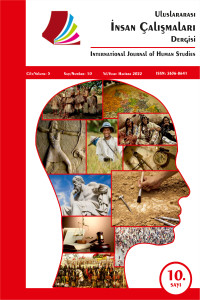Abstract
Modern çocuk edebiyatının ilk roman örneklerinden biri sayılan John Newbery’nin The History of Little Goody Two-Shoes isimli eseri ahlaki eğitim ile eğlendirici olma unsurunu harmanlar ve çocuk okuyucularına örnek bir kız çocuk karakter sunar. Newbery’nin eseri, esere ismini veren Goody Two-Shoes’ın yetim bir çocuktan meslek sahibi ve varlıklı bir hanımefendiye dönüşümü bağlamında basitçe modern bir Cinderella hikayesi olarak okunabilse de roman aynı zamanda aydınlanma prensiplerini benimsemesiyle öne çıkar. Goody Two-Shoes, diğer ismiyle Margery, John Newbery ve John Locke’un çocuk eğitimine ilişkin fikirlerini temsil etmekle kalmaz, ayrıca kendine has pedagojisi, bireyci tutumu, akılcılığa verdiği önem ve akıldışı fikirleri reddetmesi ile bir Aydınlanma Dönemi çocuğudur. Goody Two-Shoes; sabır, erdem, çalışkanlık ve özgüven gibi özelikleri kendi karakterinde bir araya getirir ve böylelikle on sekizinci yüzyıl edebiyatındaki bireyci yetişkin karakterlerin kadın ve çocuk mevkidaşı olarak ortaya çıkar. Kendi emekleri sonucunda gerçekleşen toplumsal ve ekonomik yükselişi, Margery’i ataerki tarafından belirlenmiş normatif cinsiyet rollerine itiraz eden ve böylelikle kendini yaratan bir çocuk kılar. Bu çalışma, Newbery’nin The History of Little Goody Two-Shoes isimli eserini özellikle Margery’nin gelişimine ve onun temsil ettiği değerlere odaklanarak, Aydınlanma Dönemi çocuk edebiyatı örneği olarak analiz eder.
References
- Avery, G. (2012). Written for children: two eighteenth-century English fairy tales. Marvels & Tales, 16(2), 143-155.
- Bottigheimer, R. B. (1998). An important system of its own: defining children’s literature. The Princeton University Library Chronicle, 59(2), 191-210.
- Brown, G. (2006). Metamorphic book: children’s print culture in the eighteenth century. Eighteenth-Century Studies, 39(3), 351-362.
- Crain, P. (2016). Reading children: literacy, property, and the dilemma of childhood in nineteenth-century America. Philadelphia: University of Pennsylvania Press.
- Fleming, P. C. (2013). The rise of the moral tale: children’s literature, the novel, and the Governess. Eighteenth-Century Studies, 46(4), 463-477.
- “Goody two shoes” (2022). In Oxford Learner’s Dictionaries. Retrieved from https://www.oxfordlearnersdictionaries.com/definition/english/goody-two-shoes?q=goody+two+shoes
- “Goody-goody” (2022). In Cambridge Dictionary. Retrieved from https://dictionary.cambridge.org/tr/s%C3%B6zl%C3%BCk/ingilizce/goody-goody?q=goody+two+shoes
- Klemann, H. (2011). The matter of moral education: Locke, Newbery, and the didactic book-toy hybrid. Eighteenth-Century Studies, 44(2), 223-244.
- Leeson, R. (1982). Not in front of the children? English in Education, 16(2), 26-33.
- Locke, J. (1779). Some Thoughts Concerning Education. London: Tonson.
- Newbery, J. (n.d.) The history of little goody two-shoes. London: Houlston and Son.
- Rose, J. (1995). John Newbery: the british literary book trade, 1700–1820. In J. K. Bracken and J. Silver (Eds.), Dictionary of literary biography. (pp. 216-228). Detroit, MI: Gale Research.
- Shavit, Z. (1995). The historical model of the development of children’s literature. In M. Nikolajeva (Ed.), Aspects and issues in the history of children’s literature (pp. 27-38). Westport: Grrenwood Press.
- Siderius, B. (1976). Goody twoshoes: morality through amusement. Language Arts, 53(1), 37-40.
- Veronica, S. M. C. (1965). Goody by Goldy? Elementary English, 42(5), 574-576.
Abstract
Keywords
Children’s Literature John Newbery Goody Two-Shoes Enlightenment Eighteenth Century Çocuk Edebiyatı John Newbery Goody Two-Shoes Aydınlanma On Sekizinci Yüzyıl.
References
- Avery, G. (2012). Written for children: two eighteenth-century English fairy tales. Marvels & Tales, 16(2), 143-155.
- Bottigheimer, R. B. (1998). An important system of its own: defining children’s literature. The Princeton University Library Chronicle, 59(2), 191-210.
- Brown, G. (2006). Metamorphic book: children’s print culture in the eighteenth century. Eighteenth-Century Studies, 39(3), 351-362.
- Crain, P. (2016). Reading children: literacy, property, and the dilemma of childhood in nineteenth-century America. Philadelphia: University of Pennsylvania Press.
- Fleming, P. C. (2013). The rise of the moral tale: children’s literature, the novel, and the Governess. Eighteenth-Century Studies, 46(4), 463-477.
- “Goody two shoes” (2022). In Oxford Learner’s Dictionaries. Retrieved from https://www.oxfordlearnersdictionaries.com/definition/english/goody-two-shoes?q=goody+two+shoes
- “Goody-goody” (2022). In Cambridge Dictionary. Retrieved from https://dictionary.cambridge.org/tr/s%C3%B6zl%C3%BCk/ingilizce/goody-goody?q=goody+two+shoes
- Klemann, H. (2011). The matter of moral education: Locke, Newbery, and the didactic book-toy hybrid. Eighteenth-Century Studies, 44(2), 223-244.
- Leeson, R. (1982). Not in front of the children? English in Education, 16(2), 26-33.
- Locke, J. (1779). Some Thoughts Concerning Education. London: Tonson.
- Newbery, J. (n.d.) The history of little goody two-shoes. London: Houlston and Son.
- Rose, J. (1995). John Newbery: the british literary book trade, 1700–1820. In J. K. Bracken and J. Silver (Eds.), Dictionary of literary biography. (pp. 216-228). Detroit, MI: Gale Research.
- Shavit, Z. (1995). The historical model of the development of children’s literature. In M. Nikolajeva (Ed.), Aspects and issues in the history of children’s literature (pp. 27-38). Westport: Grrenwood Press.
- Siderius, B. (1976). Goody twoshoes: morality through amusement. Language Arts, 53(1), 37-40.
- Veronica, S. M. C. (1965). Goody by Goldy? Elementary English, 42(5), 574-576.
Details
| Primary Language | English |
|---|---|
| Subjects | Creative Arts and Writing |
| Journal Section | Articles |
| Authors | |
| Publication Date | December 31, 2022 |
| Submission Date | April 16, 2022 |
| Acceptance Date | December 22, 2022 |
| Published in Issue | Year 2022 Volume: 5 Issue: 10 |



